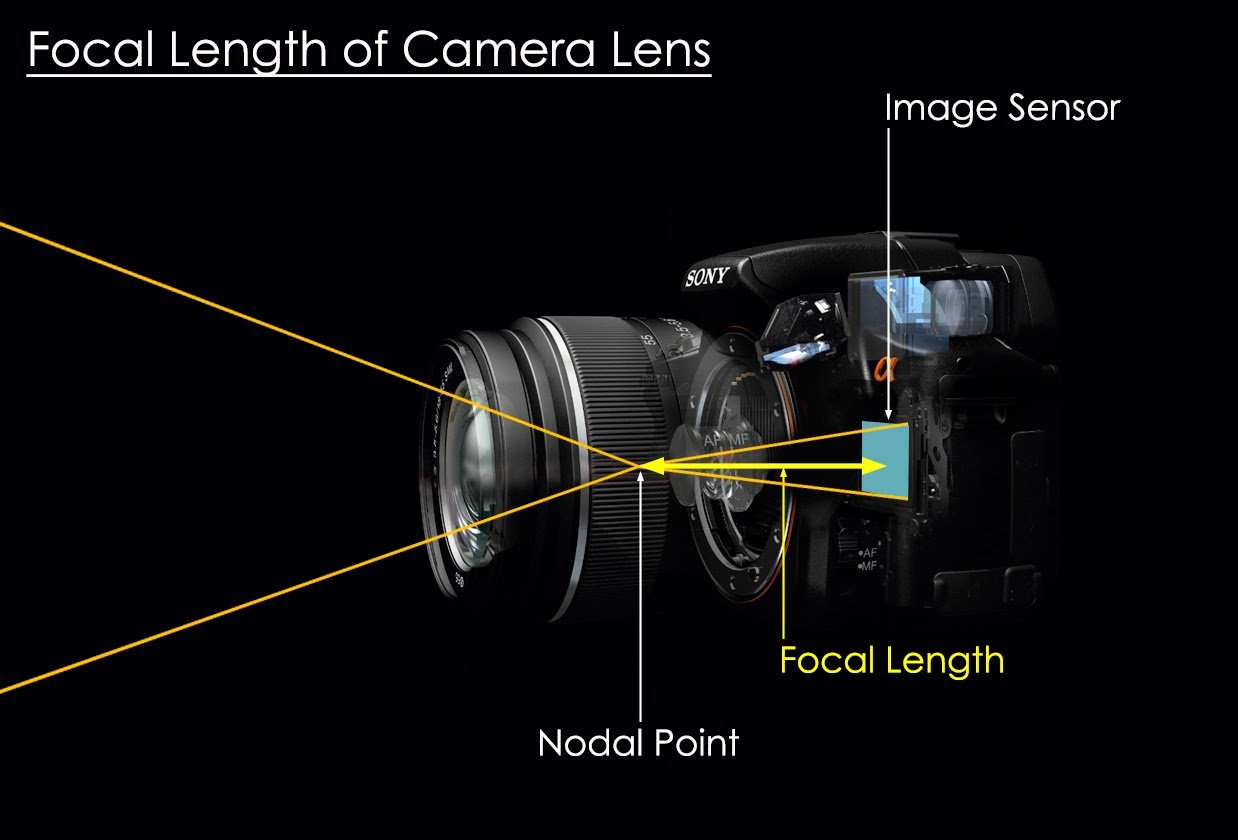
Focal length
Focal lengths are usually marked in millimetres (mm). Older lenses might use centimetres or inches.
It describes how wide the angle of view of a particular lens is: the magnification amount at which it images distant objects. Focal length is equal to the distance between the focal plane (image sensor) and the point where parallel light rays converge. The focal length is determined while focused at infinity.
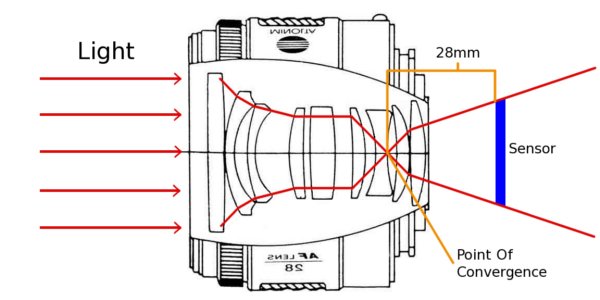
At lower values the image will show more of the scene, at higher values the image will be more zoomed in.
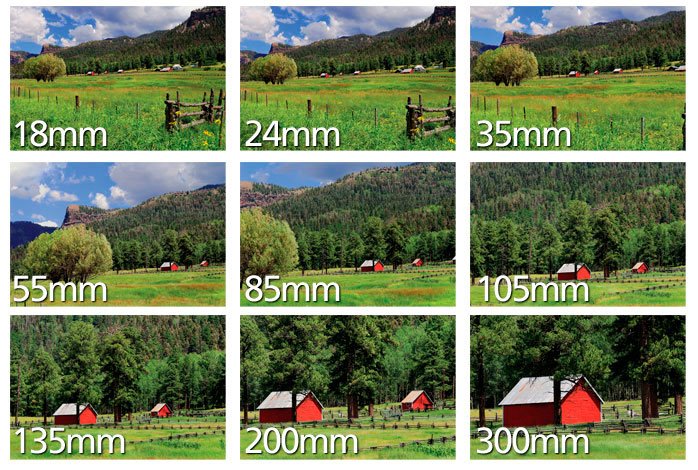
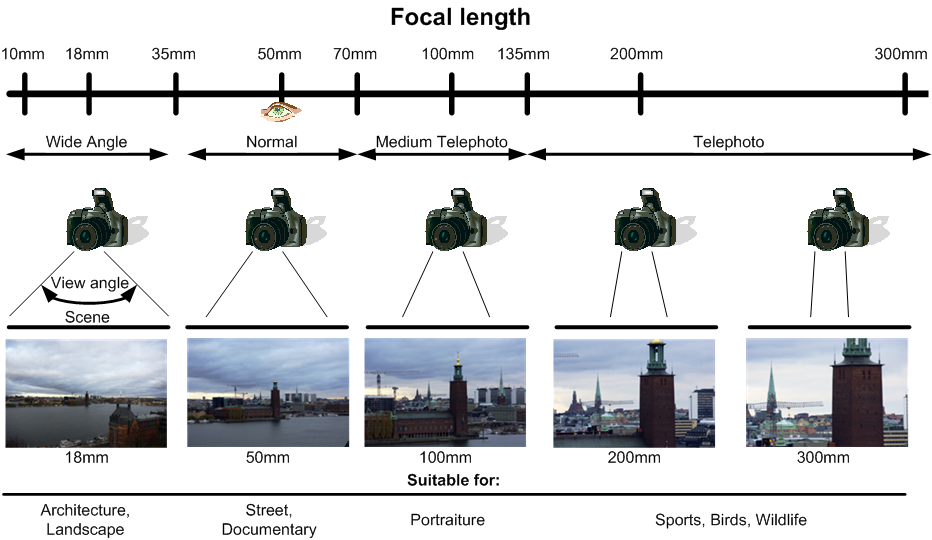

Perspective Distortion
Obviously the advantage of a higher focal length lens is that we can photograph distant objects and with a lower length we can capture a wider scene. But what happens when we focus closer. On a lens with a high focal length we'll get a pretty normal image which resembles a macro shot: our object is close in focus and the background is blown out. With a wider lens we'll perspective distortion.
Perspective distortion is something you can demonstrate yourself at any time: try putting your hand near your eye as close as you can focus. You'll see that the closest part of your hand appears relatively large compared to the parts that are further away.
You'll get this kind of distortion if you try to shoot small things with a wide lens. The classic example is in portrait photography. A good focal length for portraits is between 50 to 130 mm, but you can go higher if you want. Going wider will create noticeable distortion.

It's important to realize that all lenses have the same perspective distortion (except a fish eye or something similar). If you shoot a portrait from let's say 5 meters away with a zoom lens you'll get the same distortion on the subjects face if you were to shoot with a wide angle lens. The difference is simply that the zoom lens has a narrow field of view whereas the wide angle lens tries to squeeze everything into the frame. While you see lots of distortion with a wide angle lens shooting very close, you would see the same distortion with a zoom lens, but because it's zoomed in you'll only manage to get half of a nose into your frame instead of the whole face.
Classification
Prime lenses and zoom lenses
There are two types of lenses in general: fixed prime lenses that have their focal length set to one specific length and zoom lenses that allow to change the focal length by a set amount.
Zoom lenses let the photographer change the focal length on the go instaed of changing lenses. They can frame their shots quicker and better. Usually zoom lenses tend to be a bit less sharp than their prime counterparts. They are also bigger and heavyer.
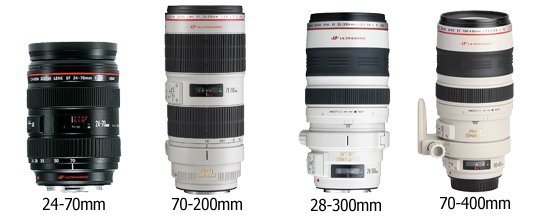
Prime lenses on the other hand are compact and light. They produce sharp images and are usually capable of shooting at lower apertures which makes them perfect for low-light situations. The only drawback is the fixed focal length which means you'll find yourself changing lenses much more often. That will increase the risk of dust and dirt getting into you camera.

Wide angle lens, standard lens and telephoto lens
Wide angle lenses range in focal length from 10 to around 35mm. These are ideal lenses for confined spaces (interiors) or landscapes.
Standard lenses range are around 50mm. These are ideal for photography in general since they are quite similar to our own field of view. Most notably used in street photography.
Short Telephoto lenses range from 90 to 100mm. They are ideal for portrait photography.
Telephoto lenses are in the 150-300mm range. They are used for distant landscape photography also for pulling in finer details on architecture or anything out of normal reach. Also sports.
Super telephoto lenses are over 300mm. They can go over 2000mm. These are ideal for sports or wildlife photography and they can zoom into finer details quite a lot. Usually these lenses are so big that they aren't suitable for shooting by hand. A tripod is recommended since the higher the focal length the higher the motion blur from your shaking hands will be. It also means you'll need a higher shutter speed which makes these lenses best used during sunny days.
Summary
By knowing the focal length of a lens we also know what the field of view of that lens will be like. According to the focal length lenses are classified from wide to super telephoto lenses and also prime and zoom lenses. Each focal length has it's own uses from landscape photography to wildlife photography. It's up to the photographer to make best use of them all.
Sources
http://www.photodo.com/topic_118.html
http://www.nikonusa.com/en/learn-and-explore/a/tips-and-techniques/understanding-focal-length.html
http://info.photomodeler.com/blog/kb/what_is_camera_focal_length/
http://www.digital-photography-student.com/lens-focal-length-explained/
https://photographylife.com/what-is-distortion/
https://en.wikipedia.org/wiki/Pinhole_camera

